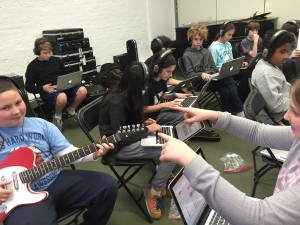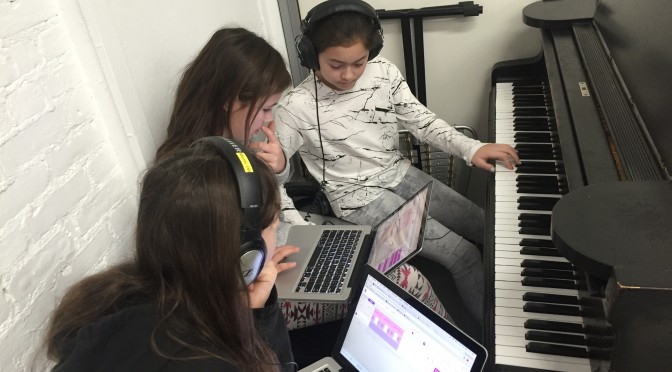
One of my main goals as a music educator is to provide authentic music-making opportunities that live in the real world for my students. I want my kids to see themselves as part of a larger community of musicians and composers, because we know that when students feel a part of something beyond the classroom walls, they are motivated to make discoveries and go deeper into the world of music. This school year I met this goal with a project-based curriculum where each of my 40 sixth graders composed and recorded an original song. Collaboration went beyond just including their sixth grade peers: students were able to invite teachers, older students, even family members to perform tracks on their song.
Below, I will outline the process, but first you can hear each of the recordings made in Soundtrap here:
Background
All of my curriculum designs aim to allow for students to engage in their work regardless of their prior experience. I want to note, however, that most of these sixth graders have participated in projects where musical skills and knowledge of concepts were developed through original composition projects. For these projects we’ve used my Young Composers & Improvisors Workshop curriculum, which you can learn more about here. My students have extensive experience with Noteflight and have composed music for chamber ensembles as well as a full orchestra.
Why Include the Community?
For our previous composition projects my students had their music performed by professional musicians and this was certainly powerful in its “real-world” quality. However, I discovered how important it is for my students to see that people they know as part of their daily school community are also lifelong music-makers. I was struck by the way in which students were so excited to include in their songs not only their classmates but also adults who they did not readily see as musicians. Every school has teachers, administrators, custodians, tech staff, cafeteria workers, or others who are passionate about music. Every music teacher has had those conversations with non-music colleagues about their musical activities or aspirations.
Our project required each student to find an adult in the building and include them as a special “musician-for-hire” on their Soundtrap recording. I curated a list of adults and the instruments they played and did some of the initial leg work by speaking with each adult about the project. It is no surprise that every adult was excited, interested, and more than willing to help out.
Why Soundtrap?
Soundtrap is a platform for making multitrack recordings in any browser or mobile device. (Picture Garageband but in the cloud.) It is an extremely exciting product for not only educators but any musician who seeks to collaborate with others. Students worked on their own original songs individually during class and at home but were also required to have three different peers perform something on their recording. We held brief “infomercials” where students could proclaim their musical skills for hire. For example, “I’m Marlowe and I’ve been playing clarinet for 3 years. I can add a clarinet track to your song…” or “I’m Liam and I love to rap! I can add a rhyme to your song if you’d like…” etc. etc.
It was the responsibility of the composer to “hire” peers and adults to add various tracks to their songs. They needed to communicate their ideas to the musician either aurally or with notation (more on this below). I helped students understand that this is how the real world of music-making works. There is a give-and-take dynamic in which, if the composer could explain what they wanted the musician to play without all of the exact details, the musician could fill in the gaps with her expertise and creativity. Or conversely, the composer may know exactly what she wants (chord progression, melody, etc. ), and it is up to the performer to interpret it correctly.
Watching Dave, one of LREI’s sixth grade humanities teachers, fill this role was a huge reminder of not only why I love being a music teacher but also why I love making music in the first place! The kids had so much fun and gained a tremendous amount of positive self- esteem from having the opportunity to give their creative ideas to their teacher — in a word, they were empowered. At the same time, Dave was also gaining a deeper connection with his students by taking part in this creative relationship that was wholly removed their humanities class.
Because each Soundtrap song can easily be shared in a similar way as a Google doc, the collaboration aspect of the project was seamless. Kids had the opportunity to record parts on their classmates’ songs not only during class time but also at home.

Why Noteflight?
The inclusion of Noteflight, a music notation web and mobile application, is not an obvious choice for this project. However, using Noteflight in the way that we did plays an extremely important role in how teachers can bridge the gap between what they know and teach and DAW-based (digital-audio workstation) applications like Soundtrap. Music teachers know music notation. They are comfortable with it and well-trained in how to help their students use music notation. Using the DAW grid-based system for musical creation is not best suited for kids to explore melodies and harmonies. The musical staff is a much better tool and one already familiar to kids through instrumental study, chorus or prior music classes. There is often a gap in how to help students create things (melodies, chords etc. ) in the grid-based, DAW environment. Barbara Friedman’s great book aside, I think there is an exciting way forward for music teachers to approach digital music creation using the staff and traditional notation. I have been exploring this concept in my teaching since 2010 and it revolves around the use of Noteflight. The way it worked in this project can be summed up in the following way: Students created their musical ideas (melodies, chord progressions, beats, etc) in Noteflight and imported them quickly into Soundtrap which has a great import MIDI function. Once these ideas are in Soundtrap students can then add recorded analog parts performed by themselves or others. They can also take advantage of the DAW’s functionality -looping, effects, audio editing etc. Because my students have a great deal of experience with Noteflight this was the workflow of choice for most. Many students also relied on the wonderful web apps aQWERTYon and Groove Pizza developed by the folks at NYU’s MusEdLab. These tools allow for kids to control Soundtrap and Noteflight in intuitive, user friendly ways. (See this post for more about the ways my students use aQWERTYon with Noteflight.) Here is an example:
Rethinking Next Steps
As with any first time project I learned a great deal and am excited to expand and improve upon it next time. I have some concrete ideas about how to include more adult musicians from the community as well as musicians from older grades. Aside from improvements I will have to contemplate how Noteflight’s new audio recording feature can be utilized. I think having the composer’s notated idea directly in the place that they’d like the performer to record the idea will be extremely beneficial. “Please record yourself playing the chord progression on the piano that goes with the violin part I wrote.” Very beneficial indeed!
But Matt, You Didn’t Explain How You Got Your Students to Write Their Songs?!?
True. Because my students have experience already being composers I can simply ask them to write a song. I know that sounds simplistic and a bit naive but it is true. Through composing music for others to play, they can work creatively with the language of music. They can make creative choices about chord progressions and harmonic rhythm, melodies and chord tones, orchestration and form and much more. My composition curriculum and teaching pedagogies are embodied in the Young Composers & Improvisors Workshop so check there for more info. Additionally, see our Music Composition as Experience resource for teachers. It includes step-by-step details about the curriculum.





Great read! This inspires me to keep going with my plans for teaching. Excited to dig into these great resources. Thank you for breaking new ground and sharing with us
Amazing stuff! This is a very valuable extension/continuation of the YCIW curriculum.
Matt, as always, thanks so much for documenting/reflecting on your practice and for providing insights on your students’ work. It is exciting to see how the student experience has evolved over time and how you continue to look for ways to ensure that your work with students and colleagues is powerfully aligned with our school’s mission and progressive purpose.
This was so, so fun to be a part of. I was honored that Matt and the students asked me to be involved and it was also a great opportunity to gain insight into my students’ creativity outside of my own class. It was also unique and informative to be an actual collaborator with a student. It wasn’t just modeling collaboration, it was actual collaborating. I highly recommend other faculty and staff music makers to participate in the future.
Congrats, Matt, for the ongoing excellent work and thank you for giving the students such incredible opportunities to make art!